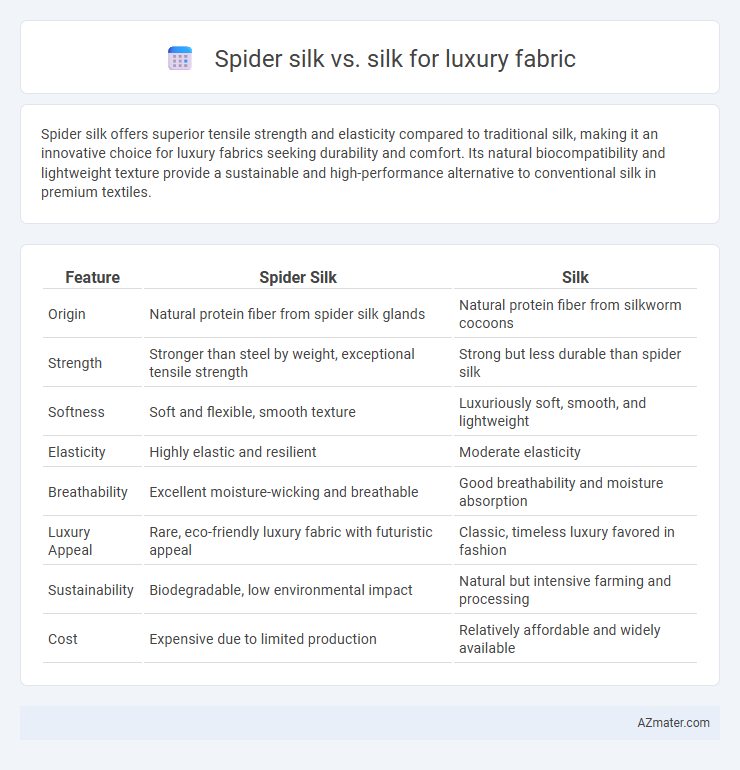Spider silk offers superior tensile strength and elasticity compared to traditional silk, making it an innovative choice for luxury fabrics seeking durability and comfort. Its natural biocompatibility and lightweight texture provide a sustainable and high-performance alternative to conventional silk in premium textiles.
Table of Comparison
| Feature | Spider Silk | Silk |
|---|---|---|
| Origin | Natural protein fiber from spider silk glands | Natural protein fiber from silkworm cocoons |
| Strength | Stronger than steel by weight, exceptional tensile strength | Strong but less durable than spider silk |
| Softness | Soft and flexible, smooth texture | Luxuriously soft, smooth, and lightweight |
| Elasticity | Highly elastic and resilient | Moderate elasticity |
| Breathability | Excellent moisture-wicking and breathable | Good breathability and moisture absorption |
| Luxury Appeal | Rare, eco-friendly luxury fabric with futuristic appeal | Classic, timeless luxury favored in fashion |
| Sustainability | Biodegradable, low environmental impact | Natural but intensive farming and processing |
| Cost | Expensive due to limited production | Relatively affordable and widely available |
Introduction to Spider Silk and Traditional Silk
Spider silk, a natural protein fiber produced by spiders, exhibits exceptional strength and elasticity, making it a promising material for luxury fabric applications. Traditional silk, harvested from silkworm cocoons, is renowned for its smooth texture, luster, and historical significance in high-end textiles. Advances in biotechnology enable sustainable spider silk production, offering a potential alternative to conventional silk with enhanced durability and eco-friendly properties.
Origins and Production Process
Spider silk, derived from orb-weaving spiders, is produced through a natural protein extrusion process involving the secretion of fibroin proteins that solidify into strong, lightweight fibers. In contrast, traditional silk originates from the silkworm Bombyx mori, where fibers are harvested after cocoon spinning, followed by reeling and weaving stages. The spider silk production is more complex and less scalable due to spiders' territorial and cannibalistic behavior, whereas silkworm farming supports large-scale, consistent yield for luxury fabric manufacturing.
Unique Properties of Spider Silk
Spider silk exhibits remarkable tensile strength, flexibility, and lightweight characteristics that surpass traditional silk derived from silkworms, making it a groundbreaking luxury fabric. Its natural elasticity and exceptional durability provide unmatched resilience and comfort, while its hypoallergenic and biodegradable nature aligns with sustainable fashion demands. This combination of unique mechanical properties and eco-friendly attributes positions spider silk as a premium, next-generation textile for haute couture and high-performance luxury garments.
Characteristics of Traditional Silk
Traditional silk, derived from the cocoons of the Bombyx mori moth, is renowned for its smooth, soft texture and natural sheen, making it a premium choice for luxury fabric. Its strong yet lightweight fibers provide excellent drape and breathability, enhancing comfort in high-end garments. Despite its delicate appearance, traditional silk offers notable tensile strength and temperature-regulating properties, contributing to its enduring status in luxury textiles.
Strength and Durability Comparison
Spider silk exhibits exceptional tensile strength, surpassing that of traditional silk produced by silkworms, with a tensile strength reaching up to 1.75 GPa compared to silk's approximately 0.5 GPa. The durability of spider silk is notable due to its remarkable elasticity and resistance to tensile forces, enabling it to absorb energy without breaking. Luxury fabrics incorporating spider silk benefit from these superior mechanical properties, resulting in garments that maintain structural integrity and longevity under stress better than conventional silk textiles.
Texture and Aesthetic Appeal
Spider silk offers a unique texture characterized by its exceptional smoothness, lightweight feel, and remarkable tensile strength, making it a highly sought-after material for luxury fabrics. Its natural luster and subtle iridescence enhance aesthetic appeal, providing a sophisticated and futuristic elegance unlike traditional silk. In contrast, silk derived from silkworms features a soft, glossy texture with a classic sheen valued for centuries in fashion and luxury textiles.
Sustainability and Environmental Impact
Spider silk offers superior sustainability compared to traditional silk, as it is produced without harming spiders or requiring intensive mulberry farming needed for silkworm cultivation. The production of spider silk generates significantly lower carbon emissions and less water consumption, positioning it as a more environmentally friendly luxury fabric alternative. Moreover, spider silk's biodegradability and renewable sourcing contribute to reducing textile industry waste and pollution, enhancing its eco-conscious appeal.
Challenges in Spider Silk Fabrication
Spider silk presents significant challenges in fabrication due to the difficulty of farming spiders, as they are territorial and cannibalistic, making mass production problematic. Synthetic spider silk production requires complex genetic engineering and precise protein spinning techniques to replicate its natural strength and elasticity. Despite its superior strength and biodegradability compared to traditional silk, scaling spider silk for luxury fabric remains limited by high production costs and technological constraints.
Luxury Fashion Market Implications
Spider silk offers unparalleled tensile strength and biodegradability compared to traditional silk, positioning it as a revolutionary material in luxury fashion. Its rarity and sustainable production appeal to eco-conscious consumers, driving high market value and exclusivity in designer collections. Investment in spider silk technology signals a shift towards innovative luxury fabrics, influencing pricing strategies and brand prestige in the global luxury fashion market.
Future Prospects and Innovations in Luxury Fabrics
Spider silk boasts exceptional strength, elasticity, and sustainability, positioning it as a revolutionary material in luxury fabric innovation. Advances in bioengineering and synthetic spider silk production are enabling scalable manufacturing, promising eco-friendly alternatives to traditional silk derived from silkworms. These innovations suggest a future where luxury textiles combine high performance with environmental responsibility, transforming fashion and performance wear industries.

Infographic: Spider silk vs Silk for Luxury fabric
 azmater.com
azmater.com